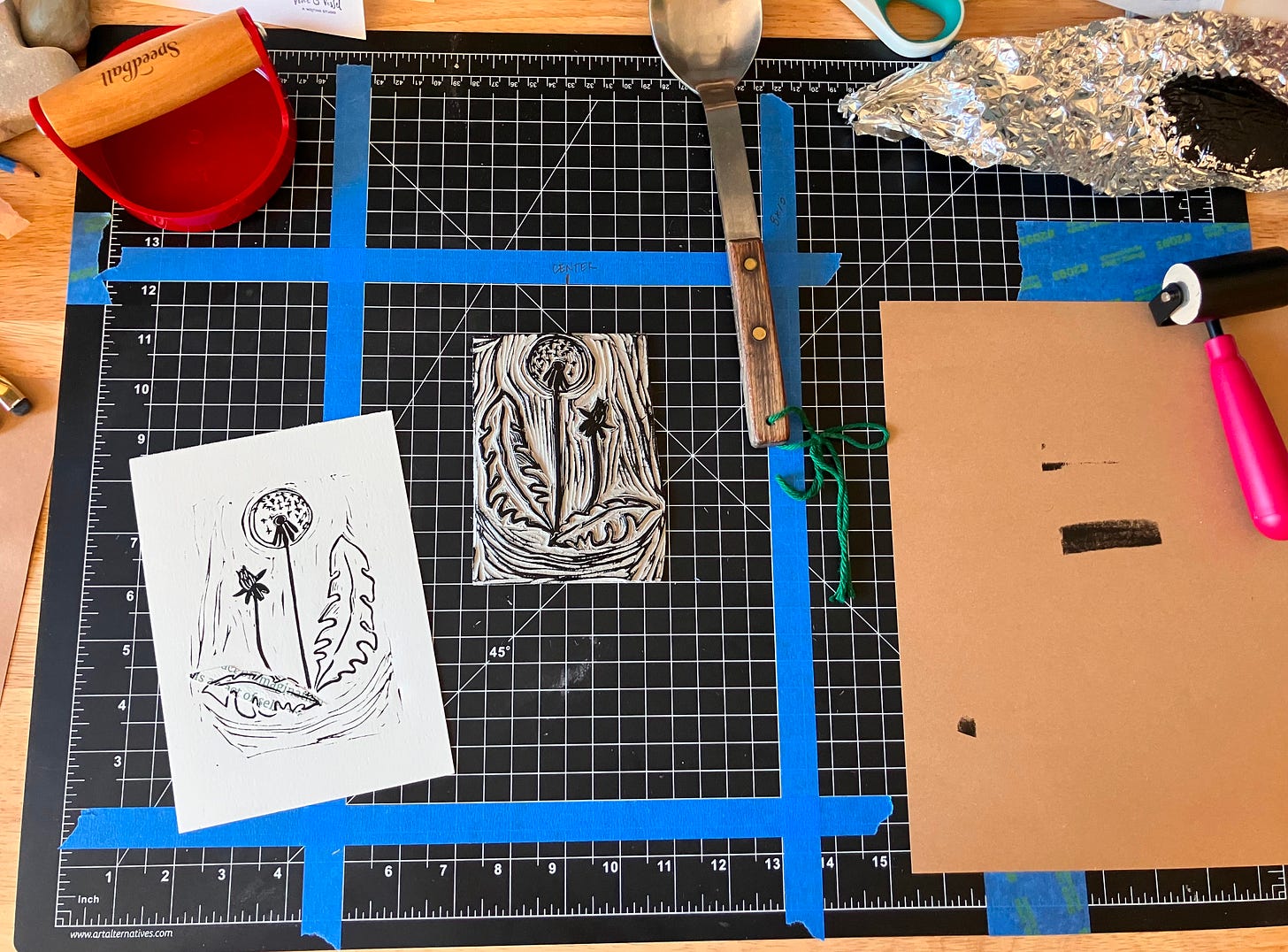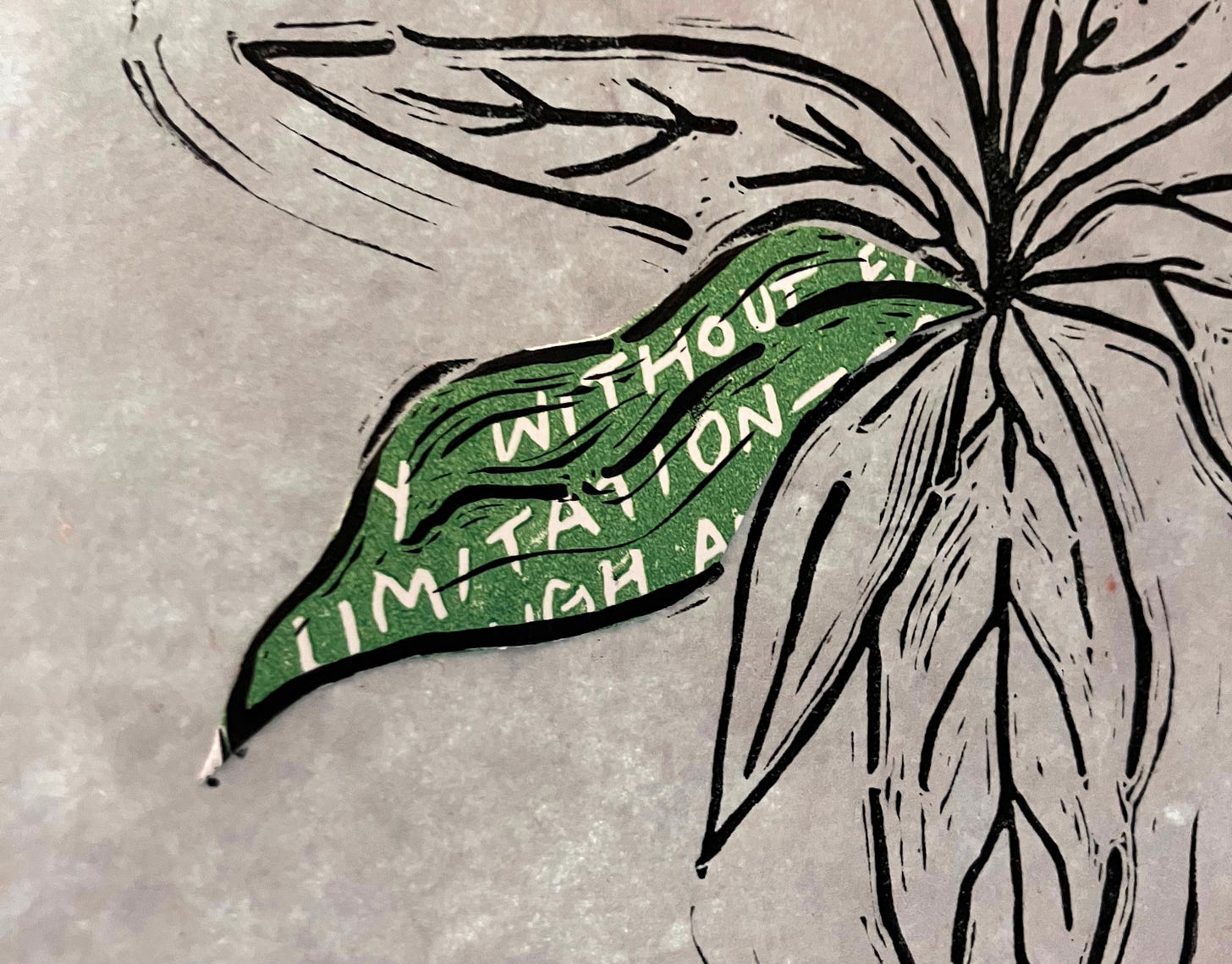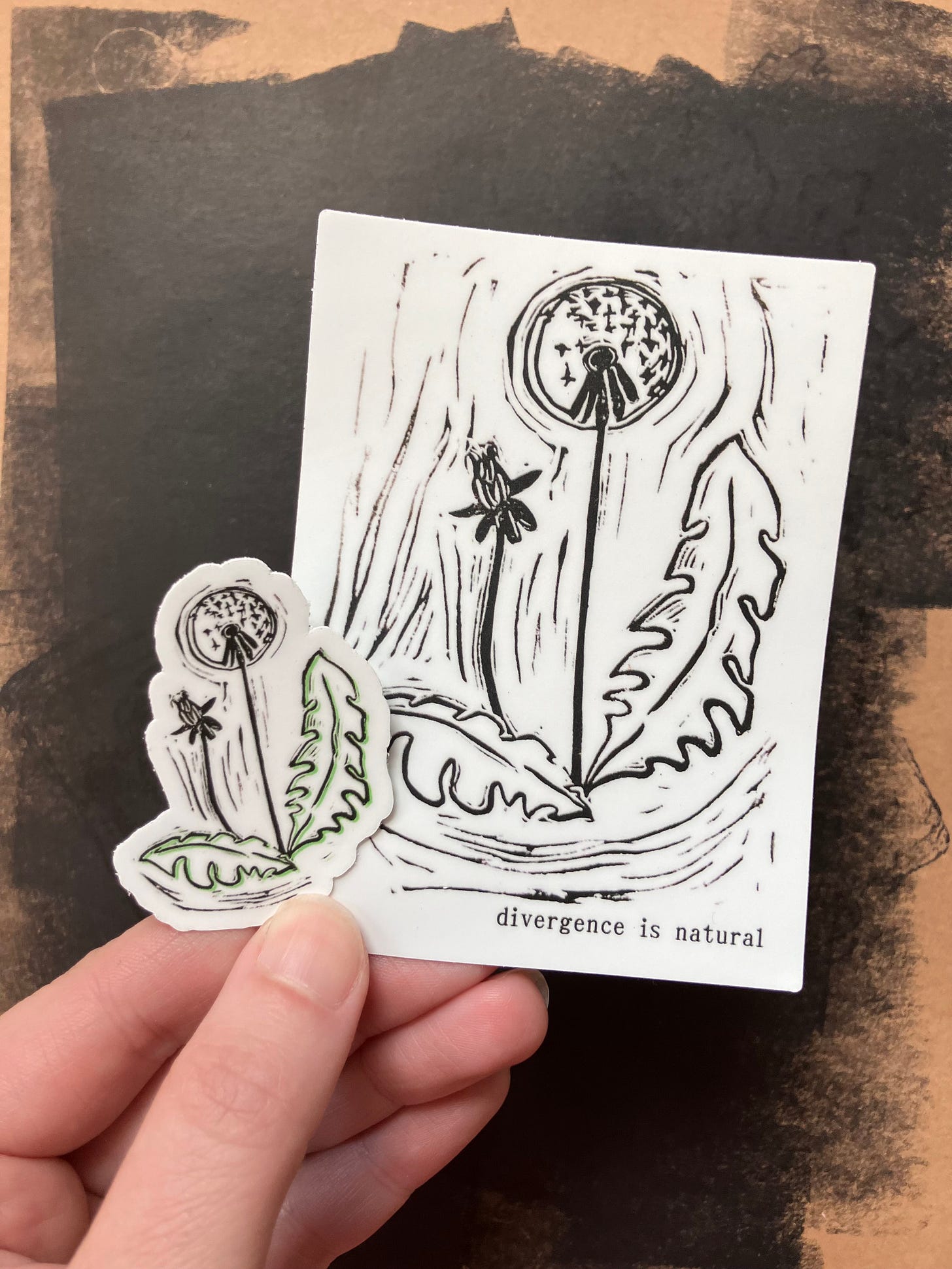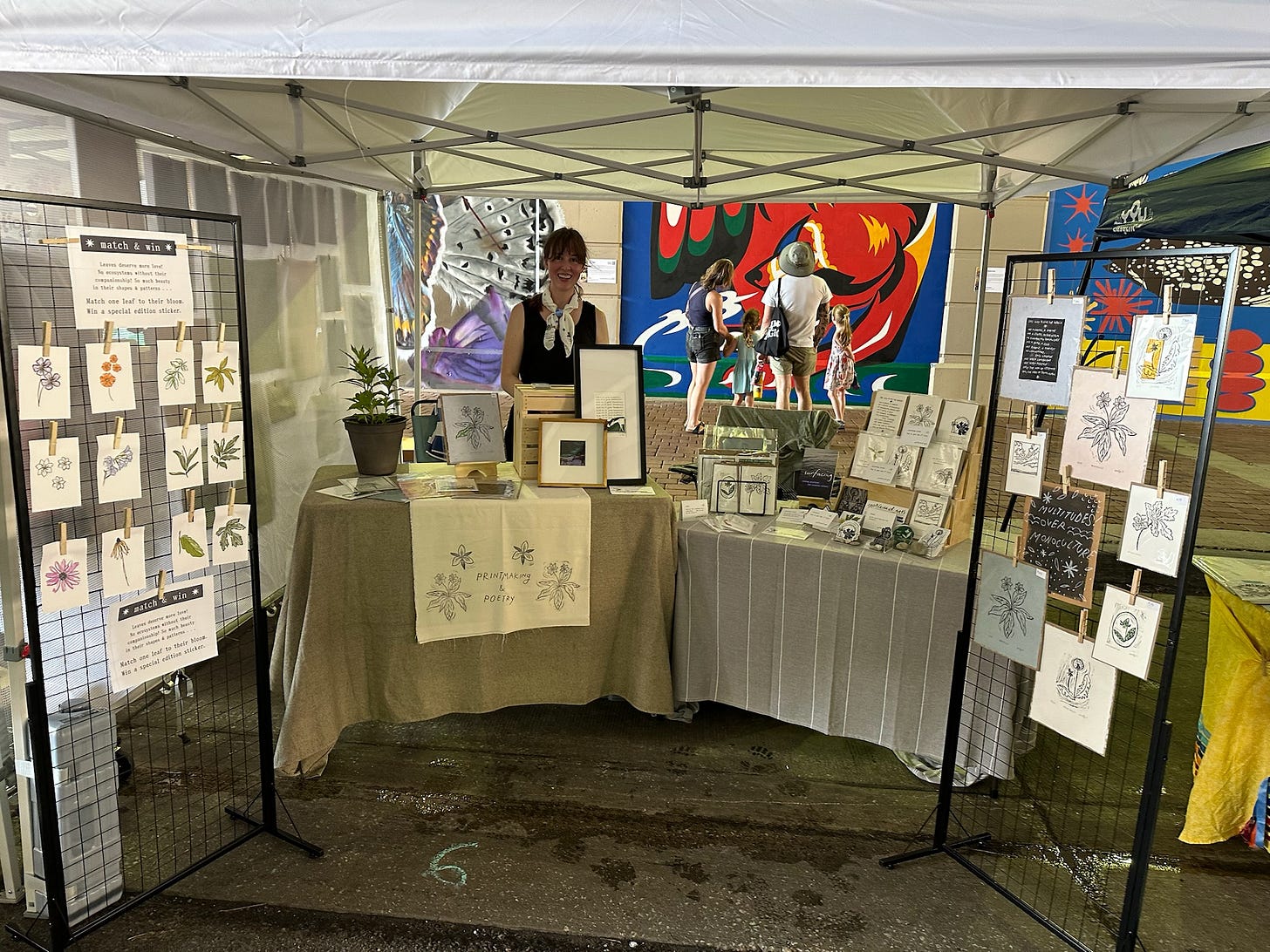The unexpected ADHD capstone project
How I put together my first art festival booth without ignoring impulsive ideas or denying my forever-restless-way-of-being
Hello from the whir of my little studio, where I tried to take a photo (above) with my newly-pressed prints recently, and Jenny flew in instead, seeing the chance to finally get a cuddle and going for it. This has basically been the energy lately.
If you’re new here, you might not know that this year I started sharing my printmaking practice as Ironweed Arts.
Bringing a visual practice alongside my writing practice is teaching me some things about the nature of my attention, especially hyperfocus. For me, writing is the peak of hyperfocus. And printmaking is . . . so chill by comparison.
Writing is bottom-of-the-sea, all-or-nothing work. I tend to forget my body when I’m in the deep of writing. I tend to fall out of time. It’s probably where the experience of time feels truest to me . . . the linearity of the world breaks.
The practice with linocut is something else. There’s still ebb and flow, but the thresholds are clearer and more forgiving. I can withstand more disruptions. I can stop to eat or run an errand and not feel like I’ve ruined the flow. I’m still surprised by how often I notice how I’m standing or pause to adjust my shoulders. I feel in my body, as I’m also in the work.
I’ve privileged the oblivion of writing for a long time. There’s a sacredness between me and that bottom-of-the-sea space. But if I’m honest, I’m relieved to find out that’s not the only way I’m capable of making art.

There’s also a clearer sense of when a piece of art is finished—unlike writing, where the meaning of “done” shifts a lot, even in the course of one revision session.
With linocut, I can repeat the process toward “finished” more steadily and frequently. I get to practice completion with each print, which is helping me hold the question of “is this done?” more loosely. Printmaking feels less susceptible to getting overworked than my writing does. (I’m sure there are printmakers who tussle with their work like I tussle with words . . . maybe we all have one practice where we obsess, and the other forms benefit from not having to carry that weight?)
I’ve wondered a lot how a body of work accumulates when you’re a restless person. I worry less about that now, when I see my prints hanging up in their rows to dry at the end of the day.
This also has something to do with my ongoing curiosity about feedback loops, and the feedback that naturally emerges from a practice when it is done repetitively, even ritualistically. How that feedback is especially meaningful to an impulsive person, who hates to outline her work or box in the plans for what’s next . . .
I’m all the more convinced that when I am feeling lost or creatively frantic, what I’m most in need of is not a perfect sense of direction, but a clearer line of feedback.
Less: where am I going, hypothetically? what am I missing?
More: where am I now, in the real? what’s possible from here?
I guess I’m still circling the here-ness of practice.

I promised myself I’d try sharing my work in at least one art fair or festival in 2025. I got lucky to be accepted for the artist market at Pleasant Peninsula, a national mural festival in my hometown of Grand Rapids. A dreamy first go for me . . . the event is all about the mix of art and ecology and native species and activism.
The festival was my first event with my new work. And my first big general public interaction five years into the pandemic, aside from a small book event at a local store in 2023 . . . which also means it was my first public project of this kind while knowing I have ADHD, after about five years of listening for what actually works for me with this bodymind.
As I’ve jotted down field notes after the event (which was so good!), I’ve realized this was like a capstone project. A chance to take everything I’ve learned so far and work with it in a concentrated space, to show up in the world with a body of work that reflects that progress.
Coming out of that unexpected “ADHD capstone project” space, three things have been especially helpful and clear, so I’m passing them along here in case you’re also in this kind of process . . .
less strategy, more responding
I think my mode of working has finally shifted wholeheartedly into iterating and experimenting instead of planning and goal-hopping.
Years ago some words fell in my ear that “the work leaves a wake” and about needing to “read the wake of the work.” At the time I just caught it in one of my notebooks and understood it in the abstract. Now I imagine it as a practice, a creative choice I can make, and one that comes from my natural temperament.
I’m happier when I’m experimenting with small actions and iterating—even if I don’t quite know where I’m going.
This is a responsive stance (listening to the process and adjusting for its possibilities), while a lot of my work before was from a place of strategy (listening for opportunity and architecting toward or around it).
For me, the responsive mode is turning out to be healthier. Slower, but healthier and truer. It plays well with my impulsive ideas and my migraines . . . spoon theory also comes from a kind of responsive place, so maybe it’s no wonder that I’ve shifted toward working this way.
A repsonsive mode might make the process less legible or meaningful to other folks. I’m writing all this in part to break it down for myself, to integrate it a bit more. This responsive mode doesn’t really cohere into a grand marketing plan or a seamless brand or a process that “scales.” And it’s not that it lacks vision . . . it just comes into the vision at a different angle or pace. That makes me think of spiral time . . . you can’t predict exactly where this kind of responsiveness will get you in six months. This way of working has messy fingerprints on it, but they’re your fingerprints. It involves a lot of learning and adjusting as you go, but that means there’s often something new to get curious about and cycle toward . . . because of that, at least for me, this has been a self-renewing way of working.
I don’t think I even have a big set of goals right now . . . I just have a sense of the spaces I’d like to be part of and the work that is mine to do, for now. The festival felt so collective and generous, like everyone else was there in a similar spirit . . . I feel like if you’re someone who cares about ecosystems, you’re naturally pulled to finding your place and doing your honest part—i.e., responding to the ecosystem.
Maybe that’s why as I prepared for the festival, I didn’t crash and burn like I have so many times before.
The container of the festival just gave me tons of specific moments and decision points to appreciate how real and practical this responsive / iterative approach is. And how aligned it can be with impulsive, ADHD-type ways of being . . . my impulsiveness is not a liability if I stay open to iterating with it. (My impulsiveness also isn’t a superpower or some redemptive character trait. It just is, and I’m just learning to work with it, honestly and directly.)1 2

what’s the natural unit of time you can hold?
The more I read the wake and experiment, the more I also figure out the scale of time I’m best at holding and creatively working with . . . as much as I love staying with nonlinear dreaming, events inevitably do have a set time, the world inevitably does require lead times . . . at some point, I do have to answer to the linear. So what’s the scale of linear I can hold most naturally?
I loved being able to test this over and over as I got ready for the festival, since I had about four months between applying for the artist market and the event itself.
For me, my natural unit of time works out to about two weeks.
A month is too much.
A quarter is too unpredictable, too loose.
Credit where credit is due—I meet weekly with a great coach who understands ADHD, and this “let’s try two weeks at a time” thing was originally her suggestion just to start organizing the work. It’s morphed into something more essential, almost like a guiding principle, thanks to her help. 3
Two weeks is enough space to leave room for creativity and not deny myself exploration when new ideas pop in . . . it also leaves some wiggle room for the disruption of my migraines / chronic pain . . . but it’s short enough that there’s urgency, a need to prioritize what fits and what doesn’t in that timeframe.
The feedback loop is also quick enough that I can check in and re-shuffle priorities if it seems I’m going off-track of the big picture (e.g., having a finished booth ready for the art festival).
Two weeks is just wide enough that I get to have fun in the forest, but small enough that I remember to water the trees. 4
enough urgency to get persistent (& the beauty of 11 x 17 paper)
If you feel like you’re failing or not following through on your projects, maybe don’t beat up the work itself. Maybe don’t hate yourself for being inconsistent. Maybe ask about your relationship to time, and effort over time.
In some post long ago, I read about ADHD folks needing to value persistence more than consistency, and that felt so right-on to me.5 What scale of time gives you spaciousness to be creative but urgency to get persistent about a project?
It does not cheat a dream or a project to scale it to the width and depth of what you can hold, right now, for now. It does not violate the idea or invalidate the work.
Again, it’s two weeks for me. But there were only so many two-week windows to work with, and some things did not get done for the festival. I didn’t end up being able to make my booth signage in the way I hoped, but the good news was that I knew why that was and the trade-offs I had made. I could concretely say: this part of my booth is lackluster because I chose to make a fun business card instead.
I cringe at how basic that sounds. But it’s surprisingly nice to feel good about a series of choices (to even remember the choices I made, ha) instead of beating myself up for what didn’t get done. It’s a relief to feel less vigilant about my work. (Persistence and vigilance are easily confused in a lot of productivity advice, but they are not the same thing.)
As I got closer to the art festival, the two-week window evolved into a 10-day countdown, shared in the photo above. I doodled it out on an 11 x 17 sheet of paper, so I could see the full horizon of the final countdown in one spot.
My last thought on all this for now, and it’s a silly-specific one, but: 11x17 paper is a magical format. Maybe you don’t need a new planner. You need a ream of 11x17 paper. Ideal size for keeping on your desk, under a keyboard, nearby for scribbling down things you don’t want to forget, making mind maps or brain dumps, doodling while you wait for your zine to finish printing, etc. So satisfying to rip up into strips when you’re done with the project. Easy to fold and tuck into another notebook or folder if there’s something you want to keep.
✷ oh god, were you expecting a conclusion?
This is ongoing learning, and that’s all the dispatch that was meant for today . . . all of my writing lately has had an aversion to endings! Maybe it’s another way the responsive stance is softening and slowing my process. I suppose that’s also why they’re field notes and not scripts. Sometimes in my voice notes to friends I just blurt out, “ok! the end!” It’s a sure sign I trust someone. So I guess I’m trusting you right now, as I say that’s all for now, and hope it is enough. ✷
This is probably why I’m floating toward the “way of being” language these days, even though that feels a bit mushy. I just don’t want to inadvertently add to the diagnosis dynamic (impulsivity = bad) or create more lift for the superpower-redemption-arc. May the ongoing cantankerousness with the language be a little salt in the DSM waters.
My impulsiveness is actually more of a liability when I take advice that tries to manage it like it’s a feral animal. I’m more interested in natural habitats than productivity hacks.
As someone who can’t take ADHD meds (yay migraine triggers) and has to navigate my hyperdrive ~*organically*~, a coach has been helpful. I know “coaching” means a lot of things these days and ADHD coaching in particular is all over the map, but I got lucky to find one who gets it, and it’s made a difference for me. If you’re curious about this, let me know! I could share some more. Or maybe it’s a zine idea.
The two-week sprint concept isn’t new, and I’m sure I’m influenced by that too. But that comes from an engineering mindset / pragmatic view of work, and I’m interested in “two weeks” here for its contradictory spaciousness, for lack of a better phrase? I’m curious about it as a way of relating to practice rather than simply organizing time and priorities . . . one of my favorite workshops I did was about two weeks, and I’ve wondered about playing with the format some more in light of what I’ve noticed this summer.
This might have been on Instagram? I don’t remember but would love to credit my source on this. If you have any idea or links, drop a comment, please and thanks!





I feel some sort of deep resonance with so much you write about the ways you are now doing or being your creative that are helpful to you. I am not ADHD, yet still much of your sharing strikes me as pertinent to myself somehow - can't articulate it much if at all yet, but I feel stimulated positively in my own challenges to somehow be able to include my varied areas of creative - writing my memoirs, singing, visual art in terms of collage and some sort of impressionistic pastel drawing, poetry, photography - and to do so with a very small space in a HUD apt. where currently I am taken up with reorganizing all my various creative supplies, sorting and recycling, on a timeline of being inspected to be up to HUD and apt. standards of safety and health which are not at all understanding of creative "clutter" which they seem to be obsessively concerned with! Yet I must comply in order to stay here. All of this stimulates my CPTSD ongoing reactions, and while I see my excellent therapist weekly, which keeps me steadier and healing and growing, yet this current challenge really is testing my limits! So onward I go as best I can, doing what I can do on any given day and that needs to be enough even without much opportunity for soul-nurturing creative once I have gone walking and then engaged with my apt. "project" - so I must also realize what are my bite-size ways of working in a crowded too-small living environment while holding and nurturing my vision of what I intend to create of my living space, ah-yes, that is what I am creating right now and it is very Okay and satisfying, ultimately. Thank you always for what you share with us of your ever-enriching journeys of creativity, healing and growth :-)
A lot to love in here - I particularly resonated with your point about moving toward, "iterating and experimenting instead of planning and goal-hopping." Thanks for sharing!